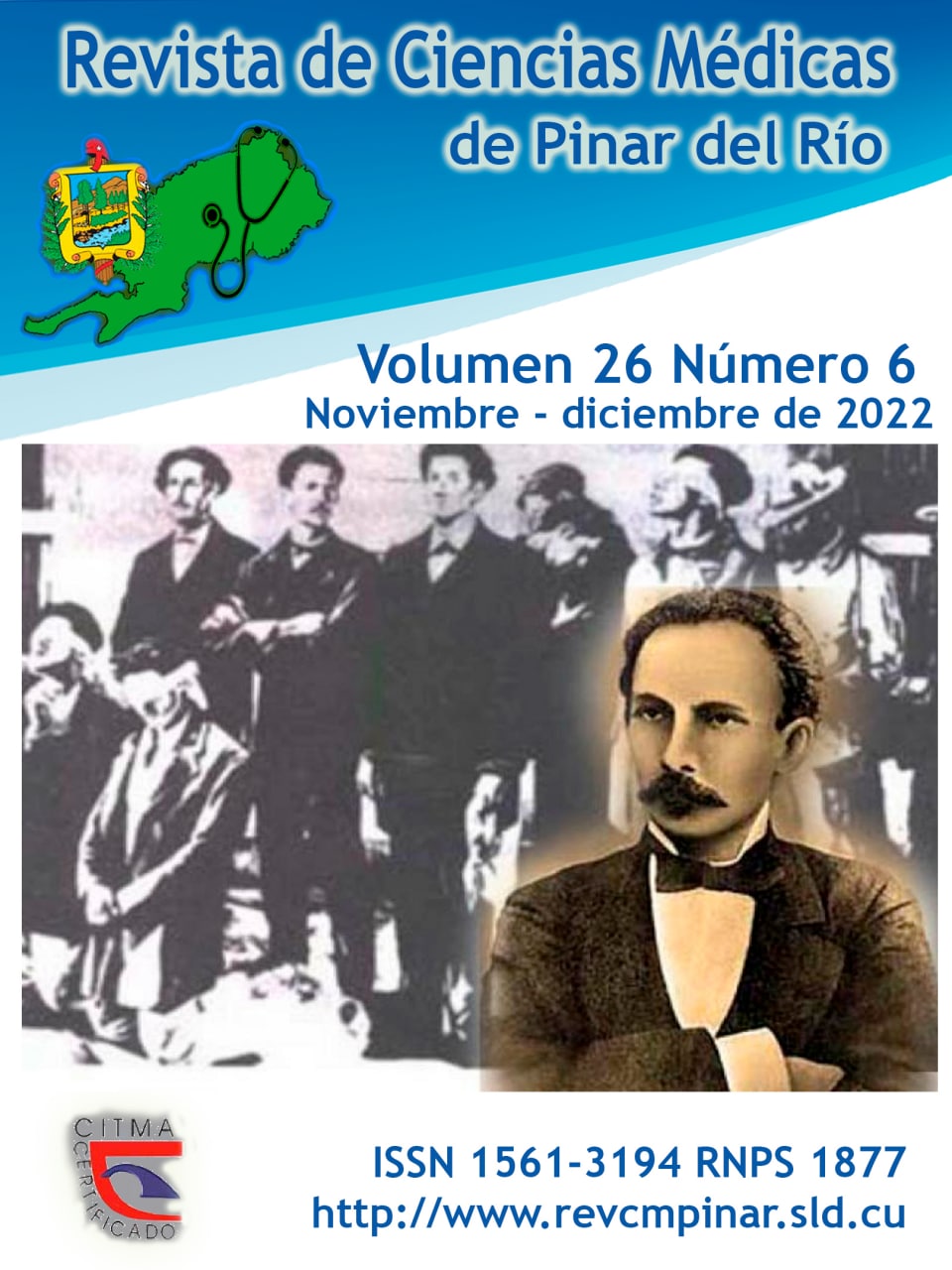Congenital heart defects in human fetuses with extra cardiac defects
Keywords:
HEART DEFECTS, CONGENITAL, SKIN ABNORMALITIES, FETUS, HEART.Abstract
Introduction: cardiac malformations are the most frequent congenital defects in humans. These are structural and functional alterations of the heart, circulatory system and great vessels that develop during cardiac embryogenesis. These defects have an impact on the quality of life of patients and their families, and a better understanding of these defects allows their prevention, diagnosis and treatment.
Objective: to identify the association between congenital heart disease and extracardiac defects in human fetuses.
Methods: an analytical and cross-sectional observational research was carried out in human fetuses obtained from pregnancy terminations performed by indication of Medical Genetics between January 2019 and May 2020 in Pinar del Rio, Cuba. The sample was represented by 42 fetuses, selected through a non-probabilistic purposive sampling. The information was obtained from autopsy reports and requests for termination. Descriptive and inferential statistics were applied to the data obtained.
Results: the study showed that most of the fetuses studied were male; ventricular septal defect was the most frequent cardiovascular defect and that among the extracardiac defects, those with the highest incidence were those of the osteomyoarticular system, showing a significant association with ventricular septal defect.
Conclusions: in human fetuses, osteomyoarticular system defects are associated with specific cardiovascular malformations.
Downloads
References
1. Iglesias Rojas M. Detección de defectos congénitos por ultrasonido durante el diagnóstico prenatal. Revista Cubana de Genetica Comunitaria. [Internet]. 2018 [citado 13/09/2020]; 12(3). Disponible en: http://revgenetica.sld.cu/index.php/gen/article/view/18/0
2. Taboada Lugo N. Consideraciones éticas en el diagnóstico prenatal y asesoramiento genético. Rev. Hum Med[Internet]. 2017[citado 13/09/2020]; 17(1): 2-16. Disponible en: http://scielo.sld.cu/scielo.php?script=sci_arttext&pid=S1727-81202017000100002&lng=es&tlng=es.
3. Suluba E, Shuwei L, Xia Q. Congenital heart diseases:genetics,noninherited risk factors,and signaling pathways. Egyptian journal of Medical Human Genetics. 2020[citado 25/11/2020]; 21(11). Disponible en: https://jmhg.springeropen.com/articles/10.1186/s43042-020-0050-1
4. Xiao-li W, Fang F, Min P, Jin H. Chromosome microarray analysis in the investigation of children with congenital heart desease. BMC Pediatrics[Internet]. 2017[citado 16/09/2020]; 17(117). Disponible en : https://bmcpediatr.biomedcentral.com/articles/10.1186/s12887-017-0863-3
5. Linte A, Balaneuscu A, Onorato E. Percutaneous closure of a large atrial septal defect in a child with severe dextroscoliosis;A case report. Exp Ther Med[Internet]. 2019[citado 20/09/2020]; 18(2): 972-975. Disponible en: https://www.ncbi.nlm.nih.gov/pmc/articles/PMC6639945/
6. Góngora Gómez O, Gómez Vázquez Y, Bauta Milord R. Cardiopatías congénitas en los principales síndromes causados por aneuploidías. Corsalud[Internet]. 2019[citado 20/09/2020]; 11(4): 353-356. Disponible en: http://scielo.sld.cu/scielo.php?pid=S2078-71702019000400353&script=sci_arttext&tlng=pt.
7. Taboada Lugo N. Avances en el conocimiento de las bases moleculares y celulares de las Cardipatías Congénitas. Parte 2 y última: Cardiopatías congénitas. CorSalud[Internet]. 2019[citado 20/09/2020]; 11(4): 307-316.Disponible en: http://www.revcorsalud.sld.cu/index.php/cors/article/view/560.
8. Valentín A. Cardiopatías congénitas en edad pediátrica,aspectos clínicos. Rev Med Electrón[internet]. 2018[citado 20/09/2020]; 40(4). Disponible en http://scielo.sld.cu/scielo.php?script=sci_arttext&pid=S1684-18242018000400015
9. González N, Jimenez R, Orcaña M. Cardiopatías congénitas diagnosticadas prenatalmente en Cienfuegos.Estudio de 10 años. Finlay[Internet]. 2019[citado 21/09/2020]; 9(1) 20-25.Disponible en: http://www.revfinlay.sld.cu/index.php/finlay/article/view/684.
10. Orraca M, Almenares S, Álvarez S. Características Clínico Epidemiológicas de las Cardiopatías Congénitas,Pinar del Río,Mayo 1999-Mayo 2001. CITMA,Ciencia Tecnología y Medio Ambiente[Internet]. 2004[citado 14/09/2020]; 6(1): p. Disponible en: http://www.ciget.pinar.cu/Revista/No.2004-1/cardiopatias.htm
11. AMM. Declaración de Helsinki de la AMM- Principios éticos para la investigación en seres humanos. AMM.[Internet]. 2017 [citado 30/06/2020]. Disponible en: https://www.wma.net/es/policies-post/declaracion-de-helsinki-de-la-amm-principios-eticos-para-las-investigaciones-medicas-en-seres-humanos/.
12. Benavides A, Faerron J, Romero J. Epidemiología y registro de las cardiopatías congénitas en Costa Rica. Rev Panam Salud Publica[Internet]. 2011[citado 20/08/2020]; 30(1). Disponible en: https://iris.paho.org/bitstream/handle/10665.2/9486/v30n1a05.pdf?sequence=1&isAllowed=y
13. Blanco M, Almeida S, Rodríguez G. Actualización sobre la cardiogenésis y epidemiología de las cardiopatías congénitas. Rev.Med.Electrón[Internet]. 2009[citado 20/09/2020]; 31(3). Disponible en: http://scielo.sld.cu/scielo.php?script=sci_arttext&pid=S1684-18242009000300011
14. Piloña S, Acosta R, Martínez O. Características clínico-epidemiológicas de las cardiopatías congénitas. Rev.Ciencias Médicas[Internet]. 1999[citado 23/08/2020]; 3(2). 2-12.Disponible en:
http://www.revcmpinar.sld.cu/index.php/publicaciones/article/view/65.
15. Sarmiento Y, Navarro MD, Milian RI, et al. Caracterización clínica y epidemiológica de las cardiopatías congénitas. Rev.Ciencias Médicas.[Internet]. 2013 [citado 23/08/2020]; 17(2): p. Disponible en: https://www.medigraphic.com/cgi-bin/new/contenido.cgi?IDPUBLICACION=4315
16. Quispe E, Durán M, Ramón G. MAlformaciones cardíacas y extracardíacas asociadas a transposición de grandes vasos.Revisión de 15 casos. Rev Med del Hosp Gene Mex[Internet]. 2006[citado 30/09/2020]; 69(3): 144-148.Disponible en: https://www.medigraphic.com/pdfs/h-gral/hg-2006/hg063d.pdf.
17. Taboada Lugo N. La vía de señalización Notch enel origen de algunas malformaciones congénitas. Rev Cubana de Obstetricia y Ginecología.[Internet]. 2018[citado 23/11/2020]; 44(3). Disponible en:
http:///www.revginecobstetricia.sld.cu/index.php/gin/article/view/383.
18. Boareto M, Jolly M, Lu M. Jagged-Delta asymmetry in Notch signaling can give rise to a sender/receiver hybrid phenotype. Proc Natl Acad Sci USA[Internet]. 2015[citado 24/11/2020]; 112(5): E402-9. Disponible en: https://www.ncbi.nlm.nih.gov/pubmed/25605936.
19. Moore K. Controldel desarrollo embrionario.En:Embriología Clínica. 8th ed. Barcelona.; 2011.
20. Hariri F, Nemer M, Nemer G. T-box factors:insights into the evolutionary emergence of the compllex heart. Ann Med[Internet]. 2012[citado 24/11/2020]; 44(7): 680-93.Disponible en: https://pubmed.ncbi.nlm.nih.gov/21923612/
Downloads
Published
How to Cite
Issue
Section
License
Authors who have publications with this journal agree to the following terms: Authors will retain their copyrights and grant the journal the right of first publication of their work, which will be publication of their work, which will be simultaneously subject to the Creative Commons Attribution License (CC-BY-NC 4.0) that allows third parties to share the work as long as its author and first publication in this journal are indicated.
Authors may adopt other non-exclusive license agreements for distribution of the published version of the work (e.g.: deposit it in an institutional telematic archive or publish it in a volume). Likewise, and according to the recommendations of the Medical Sciences Editorial (ECIMED), authors must declare in each article their contribution according to the CRediT taxonomy (contributor roles). This taxonomy includes 14 roles, which can be used to represent the tasks typically performed by contributors in scientific academic production. It should be consulted in monograph) whenever initial publication in this journal is indicated. Authors are allowed and encouraged to disseminate their work through the Internet (e.g., in institutional telematic archives or on their web page) before and during the submission process, which may produce interesting exchanges and increase citations of the published work. (See The effect of open access). https://casrai.org/credit/



